On our first visit to that part of the world, India delighted and amazed us.
India is a vast country, and rather than trying to do a broad survey, we decided to focus on the "golden triangle" of Delhi, Jaipur, and Agra, although we extended it into more of a "golden decagon", doing a more extensive exploration of the state of Rajasthan, an area rich in UNESCO World Heritage sites as well as natural beauty and cultural interest.
Air Connections
Our itinerary began and ended in Delhi, which simplified flights as Delhi is very well connected. India is pretty much the other side of the world from LA, so going east or west are both options. On advice from Indian friends, we chose to go round trip on Qatar Air connecting through Doha, and we splurged for business class "Q suites" with the lie-flat seats, which made the 15-hour plus 4-hour flights bearable.
|
New Delhi (3 nights)
Our hotel in Delhi, the Leela Palace,
was probably our nicest hotel of the trip.
Definitely 5-star modern luxury, with modern well-appointed "business class" hotel rooms,
with a beautifully decorated lobby looking out onto a garden with a large Buddha statue,
and other richly decorated common areas. There were several excellent restaurants.
This was a fantastic first place to land and recalibrate after our long flight.
|
Day 1 - Arrival in Delhi
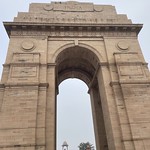 We arrived in Delhi bleary-eyed around 3am and fortunately had arranged for our hotel room to be available. After sleeping for a while, we met our friends Bruce and Nitin (who grew up in Delhi), and went for some light sightseeing. We went to the National Railway Museum, which was kind of charming because it was devoid of tourists and full of local families with their kids. We did a driving tour of the broad tree-lined avenues of embassies, Secretariat national government buildings, and the Lutyens Bungalow Zone, as Nitin gave us a primer on the civic architecture and history. We visited the Ugrasen-ki Baoli, a 14th century stepwell hidden amidst modern New Delhi. And we went to India Gate, a giant Arc de Triomphe style arch 1920s war memorial.
We arrived in Delhi bleary-eyed around 3am and fortunately had arranged for our hotel room to be available. After sleeping for a while, we met our friends Bruce and Nitin (who grew up in Delhi), and went for some light sightseeing. We went to the National Railway Museum, which was kind of charming because it was devoid of tourists and full of local families with their kids. We did a driving tour of the broad tree-lined avenues of embassies, Secretariat national government buildings, and the Lutyens Bungalow Zone, as Nitin gave us a primer on the civic architecture and history. We visited the Ugrasen-ki Baoli, a 14th century stepwell hidden amidst modern New Delhi. And we went to India Gate, a giant Arc de Triomphe style arch 1920s war memorial.
|
|
|
Day 2 - Delhi: Qutb Minar, Lotus Temple, Humayun's Tomb

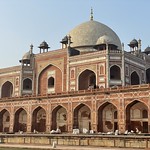 Our second day in Delhi, we hit the ground running and visited several amazing sights. First stop, the Qutb Minar complex, a UNESCO World Heritage site including the Qutb Minar (12th century, 240 feet tall, tallest brick minaret in the world), remnants of 14th century mosque and madrasa built from fragments of earlier Hindu temples, a couple of elaborate tombs, and a 4th century iron pillar which amazingly resists rust. Second stop was the Lotus Temple, a beautiful piece of modern architecture, and one of the largest Baha'i Faith temples, it resembles a giant lotus blossom built of white marble. The rest of the afternoon was spent at another UNESCO World Heritage site, Humayun's Tomb, a masterwork of Mughal architecture set in a large enclosing "paradise garden" containing several other smaller tombs and monuments as well. Stunningly beautiful! We capped the day with a stop at Dilli Haat, an open-air crafts market with craftsman, musicians, and dancers from all over India.
Our second day in Delhi, we hit the ground running and visited several amazing sights. First stop, the Qutb Minar complex, a UNESCO World Heritage site including the Qutb Minar (12th century, 240 feet tall, tallest brick minaret in the world), remnants of 14th century mosque and madrasa built from fragments of earlier Hindu temples, a couple of elaborate tombs, and a 4th century iron pillar which amazingly resists rust. Second stop was the Lotus Temple, a beautiful piece of modern architecture, and one of the largest Baha'i Faith temples, it resembles a giant lotus blossom built of white marble. The rest of the afternoon was spent at another UNESCO World Heritage site, Humayun's Tomb, a masterwork of Mughal architecture set in a large enclosing "paradise garden" containing several other smaller tombs and monuments as well. Stunningly beautiful! We capped the day with a stop at Dilli Haat, an open-air crafts market with craftsman, musicians, and dancers from all over India.
|
||
|
Day 3 - Delhi: Akshardham, Lodi Gardens, Gurdwara Bangla Sahib
  In the morning, we visited the Swaminarayan Akshardham temple, a gigantic elaborate Hindu temple complex, a modern construction but in traditional style, from ornately carved sandstone and marble, with no concrete or steel at all. After some shopping at Khan Market, we spent a relaxing afternoon in the lovely Lodi Gardens, a large and lovely city park with a few beautiful and evocative remnants of a 15th century mosque and tomb. Toward the end of the day, we visited the Gurdwara Bangla Sahib to experience a Sikh house of worship. In the morning, we visited the Swaminarayan Akshardham temple, a gigantic elaborate Hindu temple complex, a modern construction but in traditional style, from ornately carved sandstone and marble, with no concrete or steel at all. After some shopping at Khan Market, we spent a relaxing afternoon in the lovely Lodi Gardens, a large and lovely city park with a few beautiful and evocative remnants of a 15th century mosque and tomb. Toward the end of the day, we visited the Gurdwara Bangla Sahib to experience a Sikh house of worship.
|
||
|
Jodhpur (2 nights)
The Taj Hari Mahal is a modern hotel with very comfortable rooms with all of the modern amenities. The staff were all very attentive as you'd expect at a Taj (a high-end Indian hotel group). The hotel had a decent restaurant and a very good gift shop. The location is short driving distance to most of the attractions, but nothing you would walk to.
|
Day 4 - Jodhpur: the blue city

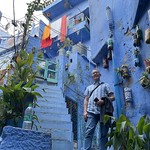 A late morning flight from Delhi to Jodhpur got us to "the blue city" in time for a late afternoon tuk-tuk and walking tour of the Sardar central market, the ancient stepwell, and the Brahmapuri old town where most of the homes and buildings are painted blue. In Jodhpur, we met up with college friends Gene and Derek, who had already been 10 days in India, and traveled with us the remainder of our trip.
A late morning flight from Delhi to Jodhpur got us to "the blue city" in time for a late afternoon tuk-tuk and walking tour of the Sardar central market, the ancient stepwell, and the Brahmapuri old town where most of the homes and buildings are painted blue. In Jodhpur, we met up with college friends Gene and Derek, who had already been 10 days in India, and traveled with us the remainder of our trip.
|
|
|
Day 5 - Jodhpur: Jaswant Thada royal cenotaphs, Mehrangarh Fort/Palace

 Our full day in Jodhpur began at the beautiful and ornate Jaswant Thada, the royal cenotaph and cremation ground for the royal Rajput family of Marwar. The main cenotaph is built from ornately carved white marble, on a hill above a lake, and in view of the imposing Mehrangarh fort and palace. At the fort, we admired the elaborate carvings in red sandstone and wood.
Inside we found a museum of the maharaja's royal accoutrements, like palanquins (a throne on a stretcher to be carried by several soldiers) and howdahs (a fancy saddle seat for riding an elephant in regal style). We also saw examples of miniature painting, scenes of court life painted in minute detail, sometimes using a single-hair brush.
We happened to be at Mehrengarh Fort on the day of the maharaja’s birthday. There was a military band to greet him, as well as a temple ceremony and formal greetings. We got a look as he stopped by near us.
Our full day in Jodhpur began at the beautiful and ornate Jaswant Thada, the royal cenotaph and cremation ground for the royal Rajput family of Marwar. The main cenotaph is built from ornately carved white marble, on a hill above a lake, and in view of the imposing Mehrangarh fort and palace. At the fort, we admired the elaborate carvings in red sandstone and wood.
Inside we found a museum of the maharaja's royal accoutrements, like palanquins (a throne on a stretcher to be carried by several soldiers) and howdahs (a fancy saddle seat for riding an elephant in regal style). We also saw examples of miniature painting, scenes of court life painted in minute detail, sometimes using a single-hair brush.
We happened to be at Mehrengarh Fort on the day of the maharaja’s birthday. There was a military band to greet him, as well as a temple ceremony and formal greetings. We got a look as he stopped by near us.
|
||
|
Narlai (1 night)
|
Day 6 - Narlai: Leopard safari

 Narlai is a convenient stopover on the road between Jodhpur and Udaipur. It's a small village, nestled beneath a dramatic rocky outcrop (a slightly smaller version of Uluru / Ayers' Rock), with 6000 people and seemingly nearly as many temples. The village is charming, and just wandering around snapping pictures of monkeys and cows, we met a local man who ended up showing us the way to this amazing little Hindu shrine way up a giant crevice in the rock.
Later that day, we took a jeep safari to the local lake (to see birds and crocodiles), to an ancient stepwell, and to a leopard reserve where we got to see several of those majestic creatures living their leopard life.
Narlai is a convenient stopover on the road between Jodhpur and Udaipur. It's a small village, nestled beneath a dramatic rocky outcrop (a slightly smaller version of Uluru / Ayers' Rock), with 6000 people and seemingly nearly as many temples. The village is charming, and just wandering around snapping pictures of monkeys and cows, we met a local man who ended up showing us the way to this amazing little Hindu shrine way up a giant crevice in the rock.
Later that day, we took a jeep safari to the local lake (to see birds and crocodiles), to an ancient stepwell, and to a leopard reserve where we got to see several of those majestic creatures living their leopard life.
|
|
|
Udaipur (3 nights)
The Jagat Niwas Palace is a 17th century haveli (mansion) on four floors arranged around a courtyard, situated with beautiful views over Lake Pichola (the hotel is right on the water). The restaurant and bar were on lakeside upper floors, making the most of the serene lake views. We upgraded to suites here, and the rooms were very spacious, comfortable, and with modern amenities. The location was ideal, not only for the views, but just a short walk to the Jagdish Temple, the City Palace, and lots of scenic ghats (steps down to the water), shops, and more. Highly recommended.
|
Day 7 - Kumbhalgarh Fort, Ranakpur Jain Temple en route to Udaipur
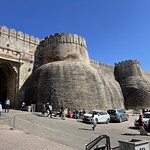
 Today was nearly five hours of driving, but it was beautiful countryside as we crossed from the desert into the Aravalli mountains, and our drive was broken up by two different and diversely stunning sights.
Coming into the Aravalli mountains, you encounter Kumbhalgarh, a 15th century fort sometimes called the “Great Wall of India”. Its massive walls stretch for miles across the mountain, a stronghold of the Mewar kingdom. Inside the walls are the remnants of a royal residence and many shrines.
At Ranakpur we saw our first Jain temple and it was astounding. The temple is a grand white marble structure spread over 48,000 square feet with 1444 marble pillars, twenty-nine halls, eighty domes and 426 columns.
Today was nearly five hours of driving, but it was beautiful countryside as we crossed from the desert into the Aravalli mountains, and our drive was broken up by two different and diversely stunning sights.
Coming into the Aravalli mountains, you encounter Kumbhalgarh, a 15th century fort sometimes called the “Great Wall of India”. Its massive walls stretch for miles across the mountain, a stronghold of the Mewar kingdom. Inside the walls are the remnants of a royal residence and many shrines.
At Ranakpur we saw our first Jain temple and it was astounding. The temple is a grand white marble structure spread over 48,000 square feet with 1444 marble pillars, twenty-nine halls, eighty domes and 426 columns.
|
|
|
Day 8 - Udaipur: Jagdish Temple, City Palace
 We had a guide-led walking tour, starting with Jagdish Temple, a large, ornately carved white marble edifice atop a high platform at the top of a long flight of white marble steps flanked by stone elephants. Its commanding presence signals its importance as a major shrine to Vishnu, in continuous use since its construction in 1651. From there, we went on to the City Palace, situated at the highest local point above the lake. It is actually a complex of palaces constructed by various maharanas across many centuries. Parts of it are still the residence of the Mewar royal family, part is a luxury hotel, and another part is a museumeum displaying royal artefacts like swords and guns, carriages, furniture, and paintings of royal court life. After exploring the palace, our driver took us to another part of the city to see Saheliyon-ki Bari (Garden of the Maidens), an 18th century garden with many prominent water features meant as a retreat for the ladies of the royal court, near another of Udaipur's lakes. We then had a lovely lunch at Tribute Restaurant, on the shore of yet another lake. The rest of the day was on our own for relaxing and some shopping.
We had a guide-led walking tour, starting with Jagdish Temple, a large, ornately carved white marble edifice atop a high platform at the top of a long flight of white marble steps flanked by stone elephants. Its commanding presence signals its importance as a major shrine to Vishnu, in continuous use since its construction in 1651. From there, we went on to the City Palace, situated at the highest local point above the lake. It is actually a complex of palaces constructed by various maharanas across many centuries. Parts of it are still the residence of the Mewar royal family, part is a luxury hotel, and another part is a museumeum displaying royal artefacts like swords and guns, carriages, furniture, and paintings of royal court life. After exploring the palace, our driver took us to another part of the city to see Saheliyon-ki Bari (Garden of the Maidens), an 18th century garden with many prominent water features meant as a retreat for the ladies of the royal court, near another of Udaipur's lakes. We then had a lovely lunch at Tribute Restaurant, on the shore of yet another lake. The rest of the day was on our own for relaxing and some shopping.
|
||
|
Day 9 - Udaipur: the lake city
 Udaipur is an absolutely enchanting city situated on several lakes. The royal palace and many mansions-turned-heritage-hotels are lakeside, along with temples and “ghats” - stair steps that lead right down into the water for ritual bathing.
Udaipur has both the serenity of its lakes, but also the cacophony of a vibrant Indian city with ancient temples jumbled next to 20th century commercial construction and remnants of once-beautiful havelis (mansions) waiting to be fixed up as the next Best Exotic Marigold Hotel. Scooters and tuk-tuks buzz around everywhere as monks light incense in shrines and chant. We spent the morning just wandering and exploring this fascinating city.
In the afternoon, we walked to the City Palace dock where we picked up a lake boat to enjoy a cruise in the late afternoon golden light. The boats stop at Jagmandir Palace, built on an island in the lake as a royal summer resort and site for royal parties.
Udaipur is an absolutely enchanting city situated on several lakes. The royal palace and many mansions-turned-heritage-hotels are lakeside, along with temples and “ghats” - stair steps that lead right down into the water for ritual bathing.
Udaipur has both the serenity of its lakes, but also the cacophony of a vibrant Indian city with ancient temples jumbled next to 20th century commercial construction and remnants of once-beautiful havelis (mansions) waiting to be fixed up as the next Best Exotic Marigold Hotel. Scooters and tuk-tuks buzz around everywhere as monks light incense in shrines and chant. We spent the morning just wandering and exploring this fascinating city.
In the afternoon, we walked to the City Palace dock where we picked up a lake boat to enjoy a cruise in the late afternoon golden light. The boats stop at Jagmandir Palace, built on an island in the lake as a royal summer resort and site for royal parties.
|
||
|
Bundi (1 night)
|
Day 10 - Chittorgarh en route to Bundi

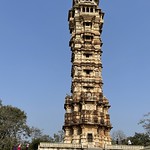 This was a five-hour drive day, but with an amazing stop about midway to break it up nicely. Chittorgarh is an amazing fort built atop a mountain ridge, with an 18 kilometer wall encircling an area including palaces, temples, and lakes. Some people still live inside the fort even today (though a larger city has grown below). The most prominent structure is this 120-foot tall limestone victory tower erected in mid-1400s. It has a unique design that is narrower in the middle and wider at top and bottom. It is completely covered in ornate carvings.
This was a five-hour drive day, but with an amazing stop about midway to break it up nicely. Chittorgarh is an amazing fort built atop a mountain ridge, with an 18 kilometer wall encircling an area including palaces, temples, and lakes. Some people still live inside the fort even today (though a larger city has grown below). The most prominent structure is this 120-foot tall limestone victory tower erected in mid-1400s. It has a unique design that is narrower in the middle and wider at top and bottom. It is completely covered in ornate carvings.
|
|
|
Sawai Madhopur (3 nights)
The Zana Forest Resort in the city of Sawai Madhopur was our base for doing safaris in Ranthambore National Park. It's a new property, open for less than a year when we stayed. The rooms are all freestanding cottages, with an extremely spacious and comfortable main room and nice modern bathroom. We were grateful for an actual built-in heater that could heat the whole room. The dining room was generic and basic, with an adequate buffet, but staff that went above and beyond to be accommodating.
|
Day 11 - Bundi: Royal cenotaphs, Queen's stepwell, Bundi Palace / Taragarh Fort

 Today we spent exploring Bundi, which is very much off the tourist track, but has some unexpected delights. We started at the Kshaar Bagh, where the maharajas of Bundi have been cremated for centuries. Each king has his own monument. Some of the carvings are quite intricate. It’s near a lake in a spot seemingly visited more by monkeys and cows than people, a bit overgrown but that’s part of the charm.
In the center of Bundi is the Raniji ki Baori (the queen’s stepwell). We’ve been seeing stepwells all over, but this one is unique in that it is a grand and elaborate closed structure with arches and columns and 100 steps down to the water. Derek declared it a cathedral for water. Gene said it was a cathedral that you enter at the top. At 260 feet in height (depth?), it is comparable to Notre Dame. It certainly has the same awe-inspiring quality.
Bundi has a beautiful palace built from the 17th century into the larger 14th century fort. The grand edifice perched high above the town is an imposing sight. It is no longer inhabited but still maintained.
The Bundi Palace was a beautiful and ornate stone edifice, with a style distinct from others. But the real treat is what is inside, something we hadn’t seen anywhere else: this palace has several galleries of the most beautiful fresco paintings. They were painted in the 1700s when the region had developed a culture of finely detailed painting. The finest miniature details were painted with a single hair brush. Some of the scenes depicted are of stories of the god Krishna (who was kind of a playboy), while others were of palace and court life. One of the striking things was the activities that the women participated in, including smoking the hookah and hunting all sorts of game with guns, spears, and arrows. The women in this royal family were bad-ass.
As if the Chitrasala frescoes weren’t enough, the Bundi Palace has several other galleries with fantastic frescoes in different styles. The Badal Mahal (“palace of clouds”) is the highest room in the palace and is painted walls and ceiling like the Sistine Chapel.
Today we spent exploring Bundi, which is very much off the tourist track, but has some unexpected delights. We started at the Kshaar Bagh, where the maharajas of Bundi have been cremated for centuries. Each king has his own monument. Some of the carvings are quite intricate. It’s near a lake in a spot seemingly visited more by monkeys and cows than people, a bit overgrown but that’s part of the charm.
In the center of Bundi is the Raniji ki Baori (the queen’s stepwell). We’ve been seeing stepwells all over, but this one is unique in that it is a grand and elaborate closed structure with arches and columns and 100 steps down to the water. Derek declared it a cathedral for water. Gene said it was a cathedral that you enter at the top. At 260 feet in height (depth?), it is comparable to Notre Dame. It certainly has the same awe-inspiring quality.
Bundi has a beautiful palace built from the 17th century into the larger 14th century fort. The grand edifice perched high above the town is an imposing sight. It is no longer inhabited but still maintained.
The Bundi Palace was a beautiful and ornate stone edifice, with a style distinct from others. But the real treat is what is inside, something we hadn’t seen anywhere else: this palace has several galleries of the most beautiful fresco paintings. They were painted in the 1700s when the region had developed a culture of finely detailed painting. The finest miniature details were painted with a single hair brush. Some of the scenes depicted are of stories of the god Krishna (who was kind of a playboy), while others were of palace and court life. One of the striking things was the activities that the women participated in, including smoking the hookah and hunting all sorts of game with guns, spears, and arrows. The women in this royal family were bad-ass.
As if the Chitrasala frescoes weren’t enough, the Bundi Palace has several other galleries with fantastic frescoes in different styles. The Badal Mahal (“palace of clouds”) is the highest room in the palace and is painted walls and ceiling like the Sistine Chapel.
|
|
|
Days 12-13 - Ranthambore Tiger Reserve
 Ranthambore National Park has some beautiful natural scenery and wildlife, but the star attraction are the 60 or so Bengal tigers living wild in this reserve. Since the tigers have 515 square miles to roam, and the visitors are limited in number and to specific zones, there's no guarantee of seeing a tiger. We booked three safaris over two days to maximize our chances.
Our first safari was in the afternoon. In a large open Jeep, we had an E-ticket ride on jeep tracks through wooded areas, open plains, and watering holes beneath rocky ridges. We saw a variety of deer and antelope, lots of birds, more than one mongoose, a sloth bear, and a leopard eating its kill. We stopped by a small watering hole for some great birdwatching and monkey-watching. Though no tiger, the bear and leopard were uncommon sightings, and it was an awesome day.
The next morning, we got up before dawn and it was a very cold jeep ride, but totally worth it when our guide found some fresh tracks and we got to meet tiger T-58 nicknamed Rocky. He’s 14 years old, 600+ pounds, and the largest of the 78 tigers living in the park. Our breath was completely taken away. What a majestic animal! We watched transfixed as he stretched, yawned, and strolled across the road right in front of our jeep before disappearing into the brush. On our third safari in the afternoon, we saw only sambar deer, axis deer, and gazelles amidst gorgeous scenery, but we'd seen our tiger, so we were content and enjoyed the ride.
Ranthambore National Park has some beautiful natural scenery and wildlife, but the star attraction are the 60 or so Bengal tigers living wild in this reserve. Since the tigers have 515 square miles to roam, and the visitors are limited in number and to specific zones, there's no guarantee of seeing a tiger. We booked three safaris over two days to maximize our chances.
Our first safari was in the afternoon. In a large open Jeep, we had an E-ticket ride on jeep tracks through wooded areas, open plains, and watering holes beneath rocky ridges. We saw a variety of deer and antelope, lots of birds, more than one mongoose, a sloth bear, and a leopard eating its kill. We stopped by a small watering hole for some great birdwatching and monkey-watching. Though no tiger, the bear and leopard were uncommon sightings, and it was an awesome day.
The next morning, we got up before dawn and it was a very cold jeep ride, but totally worth it when our guide found some fresh tracks and we got to meet tiger T-58 nicknamed Rocky. He’s 14 years old, 600+ pounds, and the largest of the 78 tigers living in the park. Our breath was completely taken away. What a majestic animal! We watched transfixed as he stretched, yawned, and strolled across the road right in front of our jeep before disappearing into the brush. On our third safari in the afternoon, we saw only sambar deer, axis deer, and gazelles amidst gorgeous scenery, but we'd seen our tiger, so we were content and enjoyed the ride.
|
||
|
Jaipur (3 nights)
The Narain Niwas Palace is a luxury heritage hotel in a secluded garden setting hidden in the midst of urban Jaipur. The rooms have traditional decor elements but thoroughly modern comforts. The lobby and common spaces are sumptuous. Peacocks parade around the garden courtyards. The in-hotel restaurant is very good, and there's also a trendy Italian restaurant adjacent to the property. There are some nice shopping arcades in walking just outside the grounds.
(est $150/night)
|
Day 14 - Jaipur: the pink city
 After a 4-hour drive from Ranthambore, we are now in Jaipur, the pink city. Its historic core was built in a planned design in 1727 with a harmonious style and color scheme. In the afternoon, we just relaxed and took some down time.
After a 4-hour drive from Ranthambore, we are now in Jaipur, the pink city. Its historic core was built in a planned design in 1727 with a harmonious style and color scheme. In the afternoon, we just relaxed and took some down time.
|
|
|
Day 15 - Jaipur: Amer Fort, Elephant Camp, Jantar Mantar and City Palace

 Our first full day in Jaipur was activity-packed. We made quick Instagram stops at a couple of places like the Hawa Mahal (the iconic pink palace with hundreds of windows) and the Jal Mahal lake palace, but our first hefty stop was the impressive Amer Fort whose imposing red sandstone ramparts rising high above a lake make a daunting statement to any would-be invader. The fort encloses some grand public spaces, like the marble-columned Hall of Public Audience and the dazzling Sheesh Mahal (mirror palace), as well as the maharaja's palace and gardens.
After the fort, we visited an elephant camp north of Jaipur where four generations of “mahouts” (elephant caretakers) have been breeding and caring for elephants since their great-grandfather was gifted two elephants by the maharaja for his service in the elephant cavalry. We met an elephant named Moti, 25 years old, which is middle-aged for an elephant. We got to ride her around the village and pet her and thank her for the ride.
Our first full day in Jaipur was activity-packed. We made quick Instagram stops at a couple of places like the Hawa Mahal (the iconic pink palace with hundreds of windows) and the Jal Mahal lake palace, but our first hefty stop was the impressive Amer Fort whose imposing red sandstone ramparts rising high above a lake make a daunting statement to any would-be invader. The fort encloses some grand public spaces, like the marble-columned Hall of Public Audience and the dazzling Sheesh Mahal (mirror palace), as well as the maharaja's palace and gardens.
After the fort, we visited an elephant camp north of Jaipur where four generations of “mahouts” (elephant caretakers) have been breeding and caring for elephants since their great-grandfather was gifted two elephants by the maharaja for his service in the elephant cavalry. We met an elephant named Moti, 25 years old, which is middle-aged for an elephant. We got to ride her around the village and pet her and thank her for the ride.
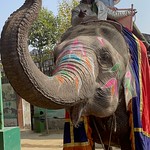 After lunch, we went into the the historic center of Jaipur. The Jantar Mantar (Hindi for calculating machine) is a collection of astronomical observation instruments like giant sundials, astrolabes, and similar devices to calculate the positions of heavenly bodies and to translate astronomical coordinate systems. At first glance, it looks like a modern sculpture park, but it was built by Maharaja Jai Singh (the founder of Jaipur) in the 1730s. This is 300 year old state-of-the-art astronomy (as well as a UNESCO World Heritage site).
From there, we toured the adjacent City Palace, which is still the home of the Jaipur royal family. There are grand elaborate gates, halls, courtyards, and galleries of royal collections. One notable item was a pair of gigantic 4000-liter silver urns that were used by the maharaja when he went to England in 1902 for King Edward VII's coronation. Untrusting of English water, he brought his own from the River Ganges.
After lunch, we went into the the historic center of Jaipur. The Jantar Mantar (Hindi for calculating machine) is a collection of astronomical observation instruments like giant sundials, astrolabes, and similar devices to calculate the positions of heavenly bodies and to translate astronomical coordinate systems. At first glance, it looks like a modern sculpture park, but it was built by Maharaja Jai Singh (the founder of Jaipur) in the 1730s. This is 300 year old state-of-the-art astronomy (as well as a UNESCO World Heritage site).
From there, we toured the adjacent City Palace, which is still the home of the Jaipur royal family. There are grand elaborate gates, halls, courtyards, and galleries of royal collections. One notable item was a pair of gigantic 4000-liter silver urns that were used by the maharaja when he went to England in 1902 for King Edward VII's coronation. Untrusting of English water, he brought his own from the River Ganges.
|
||
|
Day 16 - Jaipur: Block printing, carpet weaving, evening at Chokhi Dhani
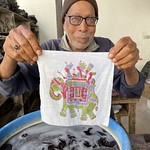 In Jaipur we were taken to a handicrafts emporium where we had some demonstrations of block printing, for which Jaipur is noted, and also carpet weaving. We bought a carpet, some tablecloths, some shirts, and a few other things. (We haven’t bought all of India yet, but we still have time.)
That evening we met up with our friend Pradeep who was in his home town visiting family. We all went to Chokhi Dhani, which is a Rajasthani cultural theme park. We enjoyed the music, dancing, traditional food, and the somewhat kitschy displays of religious and historic themes.
In Jaipur we were taken to a handicrafts emporium where we had some demonstrations of block printing, for which Jaipur is noted, and also carpet weaving. We bought a carpet, some tablecloths, some shirts, and a few other things. (We haven’t bought all of India yet, but we still have time.)
That evening we met up with our friend Pradeep who was in his home town visiting family. We all went to Chokhi Dhani, which is a Rajasthani cultural theme park. We enjoyed the music, dancing, traditional food, and the somewhat kitschy displays of religious and historic themes.
|
||
|
Suroth (1 night)
|
Day 17 - Abhaneri Stepwell, Suroth Mahal
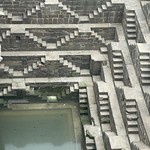
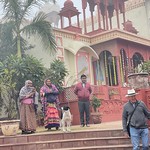 The Chand Baori (stepwell of the moon) in the village of Abhaneri is an amazing site. Dating from the 8th-9th century, it comprises some 13 stories of hundreds of stair steps leading down to the water, with an Indiana Jones worthy palace built into one side of it. It’s like an M.C. Escher painting brought to life. It's also adjacent to a lovely 9th century Harshat Mata temple. Abhaneri was a great stop to break up the 4-hour drive from Jaipur to our next stop, the rural village of Suroth (populaton 2400 families). This was a unique opportunity to experience village life, while also staying in a 600-year old palace still occupied by the descendants of the local royal family. It was palatial inside and very ornate, but also very old and with luxury on the scale of a small town. Don’t picture Buckingham Palace, rather imagine the home of a cousin of the Grand Duke of Lichtenstein. As we’ve learned, before India was unified, there were over 500 rajas and maharajas ruling over 500 larger and smaller kingdoms. This family ruled 72 villages, and were allied with the larger Jaipur maharaja. We were personally hosted by the current prince (no longer officially a thing), and his very hospitable staff. One of the palace staff lead us on a walking tour through the village, starting from a few streets lined with shops and bustling with people, but quickly turning into countryside with modest homes on decent plots of land, and open fields. We passed people walking, families out and around their homes, and some boys playing cricket. Later that evening, in the palace courtyard, there was some traditional music, and a demonstration of kushti (traditional Indian wrestling). We also joined the evening arti ceremony (lights and bells) in the hotel's in-house shrine.
The Chand Baori (stepwell of the moon) in the village of Abhaneri is an amazing site. Dating from the 8th-9th century, it comprises some 13 stories of hundreds of stair steps leading down to the water, with an Indiana Jones worthy palace built into one side of it. It’s like an M.C. Escher painting brought to life. It's also adjacent to a lovely 9th century Harshat Mata temple. Abhaneri was a great stop to break up the 4-hour drive from Jaipur to our next stop, the rural village of Suroth (populaton 2400 families). This was a unique opportunity to experience village life, while also staying in a 600-year old palace still occupied by the descendants of the local royal family. It was palatial inside and very ornate, but also very old and with luxury on the scale of a small town. Don’t picture Buckingham Palace, rather imagine the home of a cousin of the Grand Duke of Lichtenstein. As we’ve learned, before India was unified, there were over 500 rajas and maharajas ruling over 500 larger and smaller kingdoms. This family ruled 72 villages, and were allied with the larger Jaipur maharaja. We were personally hosted by the current prince (no longer officially a thing), and his very hospitable staff. One of the palace staff lead us on a walking tour through the village, starting from a few streets lined with shops and bustling with people, but quickly turning into countryside with modest homes on decent plots of land, and open fields. We passed people walking, families out and around their homes, and some boys playing cricket. Later that evening, in the palace courtyard, there was some traditional music, and a demonstration of kushti (traditional Indian wrestling). We also joined the evening arti ceremony (lights and bells) in the hotel's in-house shrine.
|
|
|
Bharatpur (1 night)
|
Day 18 - Bharatpur: Keoladeo Bird Reserve

 Today we went to Keoladeo National Park where I added 35 new birds to my life list in a couple of hours (and countless others I didn’t get a chance to identify). This place is a birdwatchers’ paradise, especially this time of year as a lot of migratory birds winter here, some from as far as Siberia. Along with all the egrets, ducks, teals, coots, herons, geese, and more, we also saw spotted deer, nilgai (largest Asian antelope), and water buffalo. It was a delightful afternoon.
Today we went to Keoladeo National Park where I added 35 new birds to my life list in a couple of hours (and countless others I didn’t get a chance to identify). This place is a birdwatchers’ paradise, especially this time of year as a lot of migratory birds winter here, some from as far as Siberia. Along with all the egrets, ducks, teals, coots, herons, geese, and more, we also saw spotted deer, nilgai (largest Asian antelope), and water buffalo. It was a delightful afternoon.
|
|
|
Agra (1 night)
The Grand Mercure was our hotel for our 1 night in Agra. It had just been bought by Accor and changed names literally days before we arrived. It's a large tall modern hotel with clean modern comfortable rooms, like a Marriott or Crowne Plaza, solid quality but fairly generic in character. The breakfast buffet was fine, but can get pretty crowded at peak hours. (est $100/night)
|
Day 19 - Fatehpur Sikri, Taj Mahal
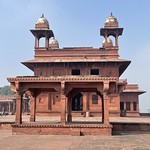
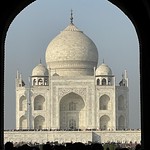 In 1571, the Mughal emperor Akbar moved his capital from Agra to a completely new planned city called Fatehpur Sikri (“victory city”), for various reasons including a prediction it would finally bring him a son (which apparently came true). It was used for not quite 40 years and was largely abandoned. It’s a fantastic time capsule of urban planning and beautiful red sandstone construction. Much has been recovered and restored, and it is a UNESCO World Heritage Site.
As we made our way into the ancient city, we came to a grand gate where we were told to remove our shoes as we were entering Muslim sacred space. The gate lead us to a large open square that contained a mosque, a shrine to the saint who predicted Akbar’s son, and an even grander gate, the Buland Darzawa or Victory Gate, built by Mughal emperor Akbar to celebrate his 1573 conquest of Gujarat.
In 1571, the Mughal emperor Akbar moved his capital from Agra to a completely new planned city called Fatehpur Sikri (“victory city”), for various reasons including a prediction it would finally bring him a son (which apparently came true). It was used for not quite 40 years and was largely abandoned. It’s a fantastic time capsule of urban planning and beautiful red sandstone construction. Much has been recovered and restored, and it is a UNESCO World Heritage Site.
As we made our way into the ancient city, we came to a grand gate where we were told to remove our shoes as we were entering Muslim sacred space. The gate lead us to a large open square that contained a mosque, a shrine to the saint who predicted Akbar’s son, and an even grander gate, the Buland Darzawa or Victory Gate, built by Mughal emperor Akbar to celebrate his 1573 conquest of Gujarat.
We’d been in India for nearly three weeks, and encountering beautiful and amazing things every single day, and worried our capacity for astonishment might be wearing down by the time we got to the Taj Mahal near the end of the trip. But then we saw it, and were in awe. It is truly magnificent. For those last golden hours of a perfect day, as the setting sun bathed the white marble in its glow, catching occasional glints of light from the gilding and semi-precious stones, we marveled at its incomparable beauty. |
|
|
New Delhi (3+ nights)
The Ambassador Hotel is a gem of Moderne architecture in the heart of New Delhi. Not only the architecture, but the interior decor — doors, carpets, guest room furniture — is delightfully Moderne. Our room had a number of great wood furniture pieces that looked like they could have been bought at the 1930 Expo. The room was spacious, and the bathroom was thoroughly modern. The location was great, a short walk to Khan Market, and not much further to Lodi Gardens, and close to everything else. A bonus is that a very good tailor has a tiny shop off the lobby, where you can pick out fabric and have shirts made. The hotel restaurant (inexplicably called The Yellow Brick Road) is merely adequate, but nothing special, and it wouldn't attract anyone from outside the hotel to dine there. But that's less important when you can walk to restaurants at Khan Market, or take a short taxi to any number of excellent places. On balance, we would definitely recommend the hotel. (est $120/night)
|
Day 20 - Agra Fort, drive to Delhi
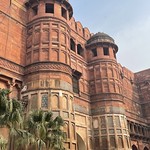 Even after the Taj Mahal, there are still other beautiful things in Agra. Agra Fort is a large fort and palace that was built up by successive Mughal emperors.
The part built mostly by Akbar in later 1500s after he made Agra his capital is made of red sandstone. It is both beautiful and formidable.
Shah Jehan, the grandson of Akbar, extended Agra Fort’s palaces in the 1600s with his preference for marble structures with inlay.
(He was warming up for the Taj Mahal.) Alas for Shah Jehan, one of his sons ruthlessly seized control, killing his brothers and putting
his father under house arrest for the last 8 years of his life. He was kept here, where he could at least watch the completion of his Taj Mahal.
After touring these marvels, we made the 4 hour drive to Delhi, with a stop for a late lunch at a dhabba (roadside fast food Indian style).
Even after the Taj Mahal, there are still other beautiful things in Agra. Agra Fort is a large fort and palace that was built up by successive Mughal emperors.
The part built mostly by Akbar in later 1500s after he made Agra his capital is made of red sandstone. It is both beautiful and formidable.
Shah Jehan, the grandson of Akbar, extended Agra Fort’s palaces in the 1600s with his preference for marble structures with inlay.
(He was warming up for the Taj Mahal.) Alas for Shah Jehan, one of his sons ruthlessly seized control, killing his brothers and putting
his father under house arrest for the last 8 years of his life. He was kept here, where he could at least watch the completion of his Taj Mahal.
After touring these marvels, we made the 4 hour drive to Delhi, with a stop for a late lunch at a dhabba (roadside fast food Indian style).
|
|
|
Day 21 - Old Delhi: Chandni Chowk market, Jama Masjid mosque

 Today we explored the wonderful chaos of Old Delhi. We came to the edge of it where our van was too big to go in, and we transferred to bicycle tuk-tuks to take us down the bustling narrow lanes into Chandni Chowk, the old market. One lane was full of things for weddings - flowers, fancy clothes, another lane was all about spices. We stopped in spice shop to smell some samples and bought some to bring home. Centuries old mosques and other buildings were tucked in between other buildings newer construction of dubious code compliance. In the street was a cacophany of street vendors (snacks, chai, flowers, and more), bikes, carts, animals, tuk-tuks, and little clusters of locals having snacks or indulging in card games or whatnot. From there we made our way to the Jama Masjid, the grand mosque built by Shah Jehan in the mid-1600s and still grand today. It is organized around a grand courtyard with a pool in the middle for ritual ablutions. It was fantastic people-watching, and we stayed to hear the afternoon call to prayer. We had lunch at a nice southeast Asian restaurant in Khan Market (walking from our hotel). In the evening, we celebrated George's birthday with a Michelin-caliber modern-Indian tasting menu at Dhilli restaurant in the Oberoi Hotel.
Today we explored the wonderful chaos of Old Delhi. We came to the edge of it where our van was too big to go in, and we transferred to bicycle tuk-tuks to take us down the bustling narrow lanes into Chandni Chowk, the old market. One lane was full of things for weddings - flowers, fancy clothes, another lane was all about spices. We stopped in spice shop to smell some samples and bought some to bring home. Centuries old mosques and other buildings were tucked in between other buildings newer construction of dubious code compliance. In the street was a cacophany of street vendors (snacks, chai, flowers, and more), bikes, carts, animals, tuk-tuks, and little clusters of locals having snacks or indulging in card games or whatnot. From there we made our way to the Jama Masjid, the grand mosque built by Shah Jehan in the mid-1600s and still grand today. It is organized around a grand courtyard with a pool in the middle for ritual ablutions. It was fantastic people-watching, and we stayed to hear the afternoon call to prayer. We had lunch at a nice southeast Asian restaurant in Khan Market (walking from our hotel). In the evening, we celebrated George's birthday with a Michelin-caliber modern-Indian tasting menu at Dhilli restaurant in the Oberoi Hotel.
|
||
|
Day 22 - New Delhi: National Museum, shopping, lunch at The Imperial
 On our last day, we visited the National Museum to see its collections of ancient Buddhist sculptures, as well as Tibetan scroll paintings, and more Mughal era miniature paintings. We did some shopping at Cottage Industries (a multi-story collection of craft vendors from many different regions, a one-stop shop for clothing, carvings, carpets, and more), and then investigated The Imperial Hotel (the "grand dame" of Delhi hotels) for lunch.
On our last day, we visited the National Museum to see its collections of ancient Buddhist sculptures, as well as Tibetan scroll paintings, and more Mughal era miniature paintings. We did some shopping at Cottage Industries (a multi-story collection of craft vendors from many different regions, a one-stop shop for clothing, carvings, carpets, and more), and then investigated The Imperial Hotel (the "grand dame" of Delhi hotels) for lunch.
|
||
|
Day 23 - Head Home
Our flight departed Delhi at 3:30am, and our hotel had been arranged for an very late check-out, so we were able to finish our final packing after dinner. We returned the same route as we had come, Qatar Air with a 4-hour flight to Doha, a 2-hour connection, and then the 16-hour flight home. We definitely appreciated the lie-flat "Q suites" we had in Qatar's business class, where we could change into pajamas and lie down and sleep. With the time change, we departed Doha at 8am and arrived to LAX at 1pm. With an afternoon to unpack, and a slightly earlier than usual crash to bed that evening, the jet lag wasn't too bad.
|
||
Reflections and Recommendations
Overall, we were very happy with this trip. We would definitely recommend Pink Vibgyor as a travel agent to book a custom trip. They do fully organized group tours as well, but for more independent-minded people like us, they also do completely custom arrangements. We gave them an outline of places we wanted to see, and they built an itinerary around that, with suggestions about places in between so that no day was too long a drive. We had a good back and forth about the sorts of hotels we wanted to stay in (we generally stayed in "heritage hotels" like old palaces, though some more modern hotels too). It was definitely the way to go to have a private car and driver for a trip like this (although we did meet one intrepid couple who was getting everywhere on Uber, even between cities).
About Suroth
Suroth is the one leg of our itinerary that I would conditionally recommend, as it may not be for everybody. Logistically, it could easily be skipped as you could just go from Abhaneri straight to Bharatpur in about the same driving time. The positive: we had a unique experience of a rural village, staying in a heritage palace where the descendants of the local royal family still live. The palace, while much smaller in scale than the palaces of Jodhpur or Udaipur, was definitely a palace with rich history and ornate construction and decor. You will meet the son of the current raja, who is very sociable and is happy to tell you about the village, the hotel, the royal family history, and life as a Rajput (Indian royalty). He's also the only one there who speaks much English. The bedrooms were charming and comfortable, furnished with traditional antique furnishings. The one off-putting aspect was the bathroom. While there was hot and cold running water, a sink, a tub, and a toilet, it was all very basic, even shabby. The fixtures are so old and worn, they would look dirty even when clean. There was a large bucket and a scoop, which we ended up using to bucket-bathe in the curtainless tub. So that's the trade-off you make. On balance, I personally found the overall experience worthwhile and would selectively recommend it to those who would accept some shortcomings for an otherwise positive experience you won't find elsewhere.
Notes On Timing
Overall, January was a good choice for this part of India. Our days were mostly in the 60s and a few in the lower 70s, and no rain, so quite comfortable, even a bit cooler than we expected. The nights got colder than we were quite prepared for, down to 50 or even 40s. Bring a puffy jacket, you'll wear it in evenings. It's important to note that most of the year India is uncomfortably hot, so hotels are generally more prepared to cool than to heat. Our one real discomfort was sometimes having rooms that were too cold. They almost always could provide a plug-in space heater, and sometimes those worked fine, but there were a couple of occasions where a plug-in space heater just wasn't going to get the room warm. Consider bringing winter pajamas, and definitely bring slippers (nearly all the nice hotels will have marble floors which are beautiful and cool in summer but cold in winter!). November or February are probably even better, or possibly March depending on your temperature sensitivity. (March also offers the bonus of being there for Holi, the holiday of colors.)
Notes On Tigers
I'd read that May (which is definitely very hot) is the best time to insure you'll see a tiger, because there are only a few sources of water then and so you just wait there. Our experience in January is that we saw a tiger on one of our three safaris, and just chatting with other tourists we met, we heard reports of 2 out of 3, 1 out of 1, and 0 out of 1, so I think if seeing a tiger is really important to you, you should plan three safaris (they run morning and evening, so that's a day and a half to do three).
Notes On Cost
For two of us, excluding international airfare and souvenirs/purchases, we spent a total of $14,400 for our vacation in India, including lodging, food, private car and driver (shared with two others for most of the trip), guides, local transport (including air connections within India), and tips, which is about $600/day for the two of us. The bulk of that ($12,436) went to our travel agent who arranged all of our hotels, transport (including private car and driver), and some meals, so it's not really possible for us to break that down into separate costs for lodging, etc. The international air was $12,500 for the two of us on business class (Qatar Air "Q Suites") from LAX to Delhi round trip. I can say that things are generally quite inexpensive in India from our American perspective. Dinner at a Michelin-level tasting menu restaurant in one of the top hotels in Delhi cost $216 for two of us. Eating in the hotel is relatively more expensive. When we ate at outside restaurants, we had good meals for $40 for two (or maybe $60 in Delhi which has bigger city prices).

No comments:
Post a Comment